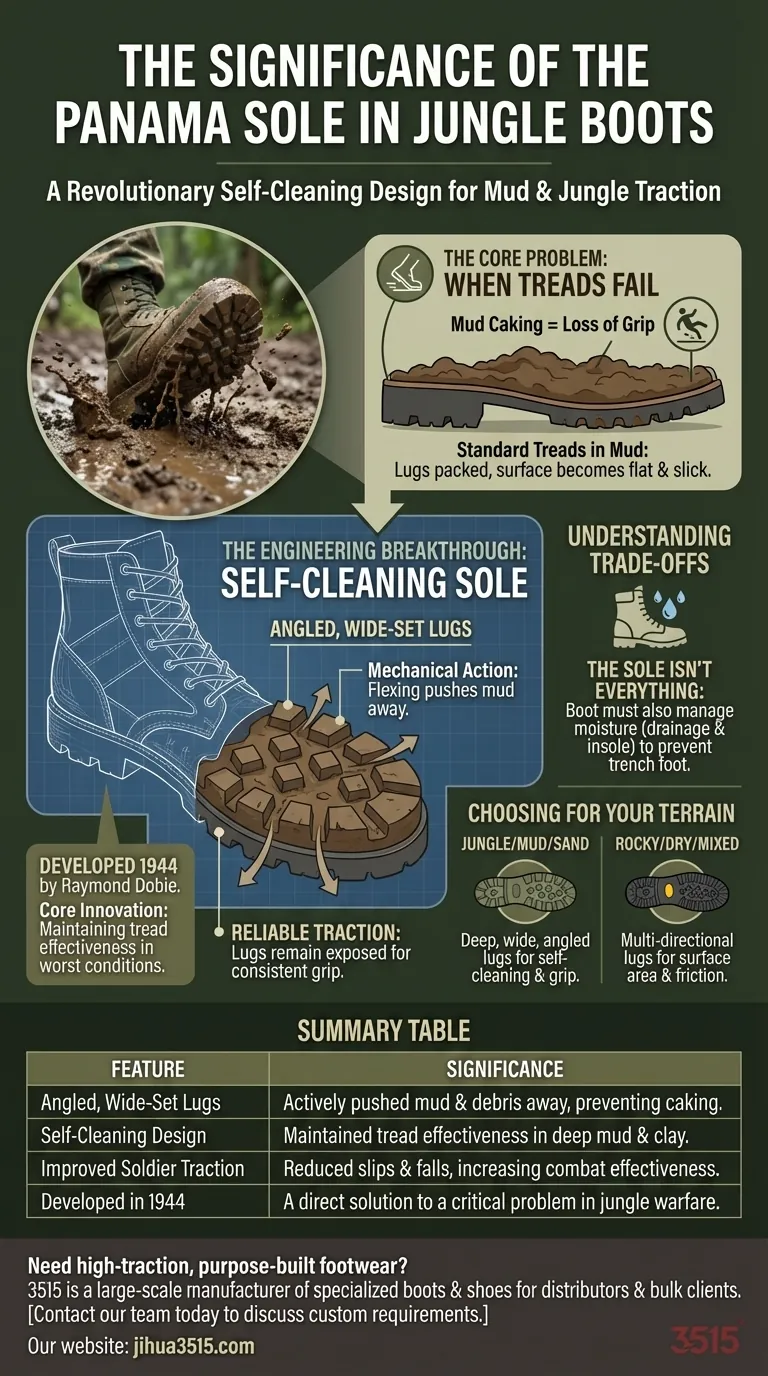In short, the Panama sole was significant because its innovative self-cleaning design solved the critical problem of mud compromising a soldier's grip in jungle environments. Developed in 1944 by Raymond Dobie, its angled, wide-set lugs actively pushed mud and debris away from the sole, ensuring consistent traction where previous designs would become caked and dangerously slick.
The core innovation of the Panama sole was not just adding tread, but engineering a system that maintained that tread's effectiveness in the worst possible conditions. It transformed the jungle boot from a liability in mud into a reliable, high-traction asset.

The Core Problem: When Treads Fail
Before the Panama sole, a soldier's greatest footwear enemy in the jungle was the environment itself. Standard boot treads, including early Vibram soles, were easily defeated by the pervasive mud and clay.
How Mud Compromises Traction
Conventional boot treads feature lugs that are relatively close together. In thick, greasy mud or clay, these channels quickly become packed with debris.
Once the tread is clogged, the bottom of the boot becomes a single, flat, slick surface. This completely negates the purpose of the lugs, leading to a dramatic and dangerous loss of grip.
The Tactical Impact of Poor Grip
For a soldier, a loss of traction is not a minor inconvenience. It leads to slips and falls that cause injury, increase fatigue, and slow movement.
A soldier struggling for footing is less combat-effective. The inability to move quickly and securely through difficult terrain was a significant tactical disadvantage.
The Engineering Breakthrough: A Self-Cleaning Sole
The Panama sole was a direct and ingenious solution to the problem of mud-caking. The design works by making it harder for mud to stick than to fall away.
Angled Lugs for Active Clearing
The key feature is a series of large, square-shaped rubber lugs that are angled outwards. As the boot flexes with each step, these angles create a mechanical action that squeezes and pushes mud out of the deep, wide channels.
This self-cleaning mechanism ensures the lugs remain exposed and able to dig into the ground, providing reliable traction step after step.
Understanding the Trade-offs
While the Panama sole was a revolutionary improvement for traction in soft terrain, it highlights that footwear is a system of compromises, with no single design being perfect for all conditions.
The Sole Isn't Everything
A high-traction sole is only one part of an effective jungle boot. The boot's upper materials, drainage capability, and insole design are equally critical.
The Persistent Challenge of Moisture
Even with a perfect sole, early jungle boots often had insoles that retained moisture. This led to severe discomfort, blisters, and fungal infections like trench foot.
A successful boot must not only provide grip but also manage water effectively, allowing it to drain and the foot to dry as quickly as possible.
Making the Right Choice for Your Terrain
The principles behind the Panama sole's design are still relevant today when selecting footwear for specific environments. Your choice of sole should be dictated by your primary use case.
- If your primary focus is deep mud, sand, or jungle terrain: Look for a sole with deep, widely spaced, and angled lugs similar to the Panama design to maximize self-cleaning and grip.
- If your primary focus is rocky, dry, or mixed terrain: A more traditional, multi-directional lug pattern (like many modern Vibram soles) may provide better surface area and friction on hard, irregular surfaces.
Ultimately, the Panama sole's legacy is a masterclass in designing equipment that solves a specific, mission-critical problem.
Summary Table:
| Feature | Significance |
|---|---|
| Angled, Wide-Set Lugs | Actively pushed mud and debris away, preventing caking. |
| Self-Cleaning Design | Maintained tread effectiveness in deep mud and clay. |
| Improved Soldier Traction | Reduced slips and falls, increasing combat effectiveness. |
| Developed in 1944 | A direct solution to a critical problem faced in jungle warfare. |
Need high-traction, purpose-built footwear for demanding environments?
As a large-scale manufacturer, 3515 produces a comprehensive range of footwear for distributors, brand owners, and bulk clients. Our production capabilities encompass all types of specialized shoes and boots, engineered to meet specific performance needs, just like the legendary Panama sole.
Contact our team today to discuss your custom footwear requirements and benefit from our expert manufacturing solutions.
Visual Guide

Related Products
- Wholesale Waterproof Tactical Boots Custom Suede & High-Traction Soles
- Factory-Direct Wholesale Canvas Boots with High-Traction Rubber Soles
- Wholesale Leather Work Boots with Customizable Wedge Sole for Brands
- Safety Footwear Wholesale Manufacturer for Custom OEM/ODM Production
- Premium Grain Leather Safety Boots for Bulk Supply
People Also Ask
- Why is waterproofing important in tactical boots? Essential for Foot Health & Mission Success
- What waterproof technology is used in tactical boots? Unlock All-Weather Performance & Protection
- Why is waterproofing important for tactical boots? Protect Your Feet and Gear in Any Mission
- What are the advantages and disadvantages of waterproof tactical boots? A Guide to the Key Trade-Offs
- Are military camouflage boots waterproof? How to Choose Boots That Keep Feet Dry



















